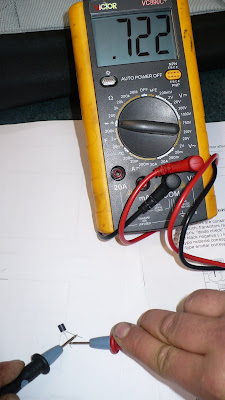

As we increase resistor value at the base, transistor starts to close and voltage drop increases at the Vce (emitter-collector)
Vbe require at least 0.7 volts for the transistor to work, so it doesn't change much.
With increasing the resistor at the base we we make transistor work less efficient so less (Ib) current flowing through the base and that effect the current flow through the collector-emitter (Ic), its also decrease.

Calculate Beta of this graph, Vce 1.5 volts
B=Ic/Ib=3.3miliAmps/55microAmps=0.0033/0.000055=60
At this graph i can see that 0.089volts at Vce transistor fully open (saturated), at 1.374volts at Vce its in active region, and at 2.35volts at Vce its cut off.



 Emitter-base always have slightly higher forward voltage drop then collecter-base, so can be identified easy with multimeter.
Emitter-base always have slightly higher forward voltage drop then collecter-base, so can be identified easy with multimeter.


